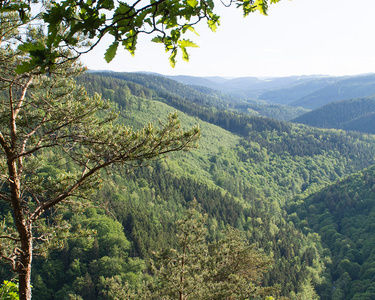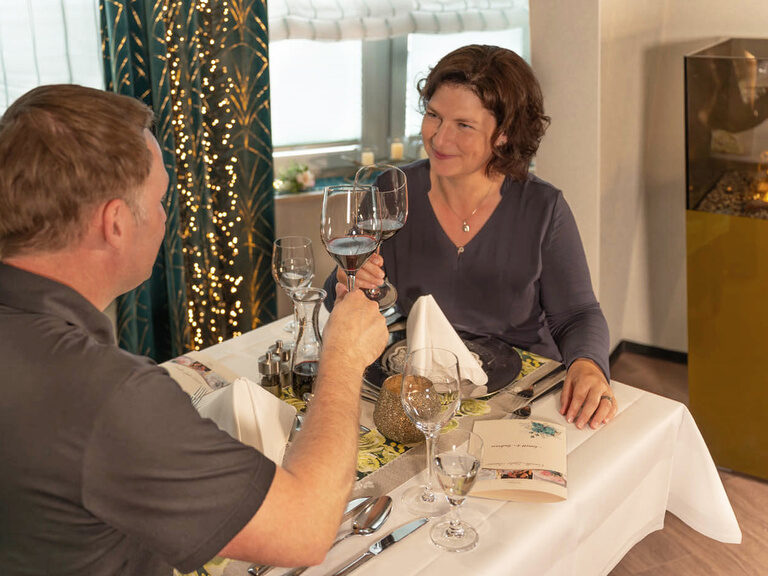of the week
from 3 days (2 nights),
daily dinner, 4 hours entry
H2Oberhof Wellnessbath
Offer of the week
Good air and healthy climate in the clean highlands of Thuringia
Along the hiking trail, you can also visit the slate-covered Church of the Redeemer in Schmiedefeld, the Kneipp spa of Stützerbach, the resort of Frauenwald and the Rennsteig Museum in Neustadt. In the climatic health resort of Masserberg, the mountain church is a popular destination, and the Thuringian Forest Nature Park Center is located in the Friedrichshöhe district of Sachsenbrunn.
The rampart of a former Celtic settlement on the Herrenberg is located in the Siegmundsburg district of Neuhaus. In Ernstthal (Lauscha), the summer toboggan run on Pappenheimer Berg is a delight. Near Spechtsbrunn (Sonneberg), the "Green Belt" hiking trail runs along the former border strip, and in Ludwigstadt in Upper Franconia, the slate museum and Lauenstein Castle can be visited.
The Thuringian Slate Park Lehesten has been a nature reserve with rare fauna and flora since 2001, and in Schlegel there is a 400-year-old wild apple tree.
The attractions of Tettau in Upper Franconia are the European Flask Glass Museum and the Tropical House Klein Eden. Incidentally, most of the sights described can also be visited by bike; the 195-kilometer route of the Rennsteig Cycle Path runs mostly parallel to the hiking trail, but avoids steep inclines.
On the way on the most popular German hiking trail
The six stages of the Rennsteig, each just under 20 to a good 30 kilometers long, can also be completed individually or combined with each other, depending on the individual duration of the vacation in the Thuringian Forest.
The start and finish points are Hörschel (Eisennach), Großer Inselsberg (near Brotterode and Tabarz), Oberhof, Kahlert and Limbach (Neustadt am Rennsteig), Steinbach am Wald (Kronach district) and Blankenstein (Saale-Orla district).
The Thuringian Forest Nature Park
However, a vacation in the Thuringian Forest is much more than "just" hiking; the Thuringian Forest Nature Park, which covers a good 2,000 km², is home to numerous culturally valuable excursion destinations. You can find out about the many interesting destinations in the eleven nature park information centers. The modernly furnished and clearly arranged facilities are located
- in the Altenstein Castle from 1736 in Bad Liebenstein, which is well worth seeing
- in Eisfeld and Friedrichshöhe in the district of Hildburghausen
- in Goldisthal, Sonneberg and Spechtsbrunn in the district of Sonneberg
- in Ohrdruf and Bad Tabarz in the district of Gotha
- in Ruhla in the Wartburg district
- and in Unterweißbach in the district of Saalfeld-Rudolstadt
In almost all of the centers, visitors can view scientifically sound and carefully designed permanent and temporary exhibitions on the geology, social and economic history of the area. Concerts of various genres, readings, performances, lectures and cultural evening events with theater or film are also frequently held in the rooms of the centers. Especially the long mining tradition of the region and the production of glass and porcelain are highlighted in depth in many places.
From Oberhof discover the entire surrounding area in no time at all
The Nature Park Information Center in Oberhof focuses on global mountain flora. The botanical Rennsteig Garden Oberhof at the Pfanntalskopf presents on 7 hectares almost 4,000 plant species from high mountains in Asia, America, the Arctic, Europe and New Zealand.
Due to the good accessibility of Oberhof from the entire federal territory, the surrounding area including the neighboring towns and communities can of course also be easily explored. Via the federal highway 71 and the state road 3247, you can reach Suhl in a short driving time, where, for example, the large weapons museum, the vehicle museum and the Bismarck tower on the Domberg are worth a visit.
There are also beautiful excursion destinations in Gotha, about 30 kilometers away. Here you should devote a few hours to the Museum of the German Insurance Industry, the Duke's Museum and the Museum of Nature Gotha. Afterwards, it's a good idea to take a stroll in the park of Friedenstein Castle, which was designed in the English style and dates back to the 17th century.
Northwest of the city lies the 431-meter-high Krahnberg, where you can get a bite to eat at the Berggarten restaurant, visit the historic Galgenplatz and rest at the Lüderitz, Mühlstein and Russenbrunnen fountains.
Popular destinations in the Thuringian Forest
Garden gnomes, toys and porcelain, blast furnace, castles and classical music concerts
The neighboring towns of Schmalkalden, Ilmenau, Gräfenroda, Arnstadt and Zella-Mehlis can also be reached quickly and easily from Oberhof by car or train (Mainfranken-Thüringen-Express and Süd-Thüringen-Bahn).
Schmalkalden is often visited because of Wilhelmsburg Castle from the late 16th century and the historic blast furnace "Neue Hütte" from the 17th century. The town in the north of the Schmalkalden-Meiningen district is also known for the traditional town festival "Hirschessen" every year on the last weekend in August.
In Illmenau, the late baroque old town center from the 18th century is particularly fascinating; architectural attractions there are the apothecary fountain and the moated castle. From Illmenau, you can drive along the tourist routes Classic Road, German Toy Road and Thuringian Porcelain Road.
In Gräfenroda, you should pay a visit to the Garden Gnome Museum, the local history museum in the Grevenrot House and the medieval fortification Raubschloss south of the town. In the oldest city in Thuringia, the "Bachstadt" Arnstadt, the summer concerts of the "Bach:Sommer" are a crowd puller, in the Johann Sebastian Bach Church the ingenious composer had his first organist position.
In the small neighboring town of Oberhof is celebrated twice a year extensively
Zella-Mehlis is located directly south of Oberhof and can be easily reached on foot or by bike.
It regularly gets a little more crowded here on Walpurgis Night on April 30 and at the town festival on the second weekend in September.
The Technical Museum at the Lubenbach with the historic drop forge, the town museum with its focus on gunsmithing and the adventure park Meeresaquarium Zella-Mehlis with about 4,000 animals from 200 species in more than 60 aquariums and terrariums on 6,650 m² of exhibition space are easy to visit all year round.
Or get to the bottom of physics in the Explorata hands-on world. Lots of experiments from everyday life to touch and try out.







